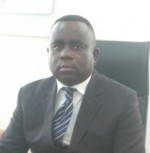Wilgon Berthold Tsibo, CTO, Equateur Telecom, Congo is speaking in the LTE Operator Strategies track on Day One of the LTE Africa 2013conference, taking place on the 9th-10th July 2013 in Cape Town, South Africa. Ahead of the conference we speak to him about the particular challenges Africa is facing as local telcos look for roll-out LTE.
April 24, 2013

Wilgon Berthold Tsibo, CTO, Equateur Telecom, Congo is speaking at the LTE Operator Strategies track on Day One of the LTE Africa 2013 conference, taking place on the 9th-10th July 2013 in Cape Town, South Africa. Ahead of the conference we speak to him about the particular challenges Africa is facing as local telcos look for roll-out LTE.
Please give me an overview of Equateur Telecom and tell me more about your customers and the wider MNO market in the Congo.
Congo is a country of four million inhabitants and there are more than 3.8 million mobile phone users; a penetration rate of 95 per cent. The MNO market Congo is composed of four operators : MTN Congo, Airtel Congo, Warid Congo & Equateur Telecom Congo (ETC), known under the trade name of Azur-Congo. MTN and Airtel enjoy the largest market share (41 per cent and 40 per cent respectively) due to the length of time they have been established in the country – nearly 15 years. Warid, with six years market presence has 11 per cent market share, and finally Azur Congo (ETC) holds eight per cent of the market after three years.
ETC is the fourth mobile operator in Congo Brazzaville and launched in 2010 in two main towns of the country – Brazzaville and Pointe-Noire. ETC has a commercial 2G license at 900 and 1800MHz frequencies and currently ETC is engaged in a deployment to achieve nationwide GSM coverage by the end 2014. We also offers EDGE services.
The customer base is mostly composed of young people, ages between 16 and 29 years old who are addicted to new technologies.
What are the biggest challenges to rolling out LTE in the Congo and the wider continent?
Most of Congo’s networks are 2G networks with some 2.5G services. One operator has started 3.75G services, but success has been limited. The biggest challenges to an LTE roll-out in the Congo will be mastering the equipment swap from 2.5G to 4G. After the swap, the second challenge will be obtaining terminals that are compatible with LTE, in order to make the product accessible to the whole population.
The LTE Africa conference is taking place on the 9th-10th July 2013 in Cape Town, South Africa. Click here to download the brochure for the event.
Will LTE act as a fixed-line replacement in Greenfield areas in Africa?
LTE won’t be a fixed-line replacement in Greenfield areas in Africa, but LTE is coming to reinforce the capacity and the diversity of services in Greenfield areas. LTE and fixed-line will keep walking together for a long time, because the availability of terminals constitutes a brake on the African LTE market boom.
What are the challenges around moving from WiMAX?
The challenges around moving from WiMAX to LTE are first and foremost adapting infrastructure to the Long Term Evolution technology and also ensuring the compatibility of terminals for the use of LTE services. Though they are close technologies in terms of development, the major challenges remain terminal availability.
FDD or TD-LTE – what is your technology preference and why?
Our preferred technology is Frequency Division Duplexing (FDD)-LTE because FDD is very good in situations where the uplink and downlink data transmissions are symmetrical (which is not usually the case when using wireless phones). More importantly, when using FDD, the interference between neighbouring Radio Base Stations (RBSs) is lower than when using TDD. Also, the spectral efficiency (which is a function of how well a given spectrum is used by certain access technology) of FDD is greater than TDD.
Are you considering network sharing agreements to lower costs and what are the regulatory issues surrounding this?
The strategy of sharing infrastructure is good as it reduces both CAPEX and OPEX. It reduces CAPEX for new operators entering into the business, because it does not have to raise large amounts of capital for its roll-out and it enables it to cover a large amount of territory through building sharing agreements. In return, the new operator will significantly reduce the OPEX of the site owner (fuel, electricity, maintenance, security, capacity) through its participation in the operational costs of the site. It will also enable the site owner to have a faster return on investment.
What particular challenges does Africa face in terms of backhaul provision?
The particular challenges are the availability of capacity at long distances from sites. Most operators use satellite links to serve remote areas but these links are very expensive and we cannot assure quality during inclement weather. The emergence of different optical fibre platforms across Africa may be a solution.
How do small cells fit into your strategy?
In our strategy, small cells are a vital for 3G data off-loading, and we will also find also small cells vital for managing LTE Advanced spectrum more efficiently compared to using just macro-cells. The current cell architectures cannot support the exponential growth in demand for data transfer over the long term. The new radical concept of small cell networks can provide a viable solution economically and ecologically.
Read more about:
DiscussionAbout the Author(s)
You May Also Like








.png?width=300&auto=webp&quality=80&disable=upscale)


_1.jpg?width=300&auto=webp&quality=80&disable=upscale)


.png?width=800&auto=webp&quality=80&disable=upscale)